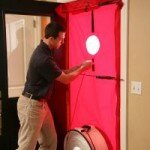Blower Door Testing
Energetechs has been performing Blower Door Tests in the Missoula, Montana area for over 22 years and we have used the results to help countless homeowners, architects, business owners, and builders improve the energy performance of their buildings.
How does a Blower Door Test work?
A blower door is a powerful fan that mounts into the frame of an exterior door. The fan pulls air out of the house, lowering the air pressure inside. The higher outside air pressure then flows in through any unsealed cracks and openings. During the blower door test we use a thermal imaging camera and a smoke pencil to detect air leaks. Detecting where the air is leaking during the blower door test is crucial to helping locate problem areas and reduce energy loss. These tests determine the air infiltration rate of a building.
Blower doors consist of a frame and flexible panel that fit in a doorway, a variable-speed fan, a pressure gauge to measure the pressure differences inside and outside the home, and an airflow manometer and hoses for measuring airflow.

A blower door consists of a calibrated fan for measuring an airflow rate, and a pressure-sensing device to measure the air pressure created by the fan flow. The combination of pressure and fan-flow measurements are used to determine the building airtightness. The airtightness of a building is useful knowledge when trying to increase energy conservation or decrease indoor air pollution, or control building pressures. A blower door test can be administered in residential, multifamily and commercial structures. In residential structures a blower door test is most often used to determine the Air Change Rate (ACH) of the structure to know how the tested building compares to other buildings throughout the world.
Preparing for a Blower Door Test
Take the following steps to prepare your home for a blower door test:
- Close windows and open interior doors
- Turn down the thermostats on heaters and water heaters
- Cover ashes in wood stoves and fireplaces with damp newspapers
- Shut fireplace dampers, fireplace doors, and wood stove air intakes.
Source: Department of Energy
How to interpret a blower door test results
Blower-door airtightness measurements are presented in a number of different formats, including but not limited to:
Air flow
CFM50 is defined as the air flow (in cubic feet per minute) needed to create a 50-pascal pressure change in the building envelope. CFM50 is one of the most basic measurements of airtightness achieved during a blower door test. Air flow measurements during a blower door test are sometimes referenced to different building pressures such as 25 or 75 pascals.
Air changes per hour at 50 pascals
In order to compare the relative airtightness of buildings that have had a blower door test conducted on them, it is useful to normalize the measurements for the size of the building. This allows easy comparison of various sized buildings to each other, or to program guidelines. One of the most common ways to normalize building airtightness is to calculate the number of times per hour that the total volume of the enclosure is changed, when the enclosure is subjected to a 50-pascal pressure difference during the blower door test. To calculate air changes per hour, the total volume of the enclosure is required in addition to the CFM50 measurement. It is also common to use the building enclosure surface area to normalize airtightness measurements.
A pressure of 50 Pa is equal to 0.2 inches (5.1 mm) of water column.
Leakage area
Leakage area estimates are a useful way to visualize the cumulative size of all leaks or holes in the building enclosure while under the induced pressure of the blower door test. Estimated leakage areas can also be used in infiltration models to estimate natural infiltration rates (i.e. the air change rate under natural weather conditions). In order to accurately estimate leakage areas, it is best to conduct the blower door test over a wide range of building pressures (e.g. 60 Pa to 15 Pa). There are a variety of standard calculation methods used to calculate leakage areas.
A typical Cost of a blower door test ranges from $200 on up depending on the size and complexity of the structure. Contact Energetechs today to discuss how we can help you save energy and improve indoor air quality through conducting a blower door test and infrared image. For more information on infrared imaging, see our Energy Auditing page.
Source: Wikipedia
- Performing a Blower Door Test during an Energy Audit
Blower Door Test Demonstration Video
CONTACT US – Energetechs, Inc., – ph.


